From 4 to 13 September (with a queue at the end of October) Ibrida – Festival of Intermediate Arts, whose fifth edition, initially scheduled for last April, has been postponed due to the Covid emergency, returns to Forlì. Ibrida will come to life in the San Domenico Arena in the spaces in front of the Museums with a parallel online platform. The organization is as usual entrusted to Vertov Project (curatorial duo composed of Francesca Leoni and Davide Mastrangelo, creators of the event) with the critical contribution of Piero Deggiovanni, professor at the Academy of Fine Arts in Bologna. The aim of the Festival is to scout the latest trends in Italian and international research in the field of experimental audiovisual, performance art and electronic music and to explore new possible areas of hybridization between the various disciplines also through specific collaborations and meetings.
To get some anticipation on the festival and to better frame its reference context, we asked Francesca Leoni and Davide Mastrangelo a few questions.
The current health situation has led you to transfer part of the Festival online: the meetings will be streamed on your social channels, the video art sections will remain available on a platform connected to the Ibrida website (only and exclusively during the days of the festival) and also the three live events held in the spaces of the San Domenico Arena in Forlì will be avaiable online upon payment of a ticket. How did you face the challenge of this rapid reprogramming and what reflections did it arouse in you?
We have faced difficult times, like everyone else, between doubts and uncertainties. It was difficult for us to predict in April what would have happened in September, when things changed from day to day. To tell the truth, despite the atmosphere of presumed normality, no one is yet able to say with certainty what will happen in the future, so we have decided to focus on the present. Despite everything we decided to go ahead and create a full-fledged “Hybrid” event, to give a clear signal to the people who follow us and to our artists, who have lived and still live dramatic moments. The hybrid formula, between live and streaming, was the most suitable for the situation and our identity and we got to work to make it come true in the shortest possible time. The creation of a special platform (HYBRID LIVE) as well as adapting to a new space (Arena San Domenico) required new and additional costs. The positive side of all this is that the people who follow us from abroad will finally be able to participate in the Festival even at a distance: a possibility that we will continue in the coming years. We do not know what the future holds, for sure all this has made us understand that it will be increasingly important to know how to adapt, in a fluid way and quickly, by exploiting new technologies to our advantage, allowing us to reach an increasingly wider audience. We feel the need to create a physical place of exchange, through meetings and live events. We have built our Festival on a sharing dimension: a place where artists, audiences, curators, researchers and enthusiasts can meet to exchange ideas and future projects.
In Europe we are witnessing a growth in festivals dedicated to video art and its surroundings, while in Italy there are still very few occasions of this type. Festivals have not only the aim to present works and artists, but also to attract and grow a community of enthusiasts who find nourishment in the exchange of reflections and experiences. How do you manage to reconcile the desire to disseminate an art form that is still considered “underground” and “niche” outside its usual audience and the ability to involve experts as well?
For us, the Festival has never been a simple showcase, rather a place for exchange, innovation, research and sharing. The show days are only the final act of a much broader path, which includes workshops, meetings, discussions and even specially created live events. In Italy, festivals are very important for the future of research: we need to rethink the present, not just the future. We try to stimulate the curiosity of a varied audience through meetings, book presentations or workshops. In these five years we have noticed a greater curiosity towards our small reality, perhaps also due to the communication we have adopted over the years. We have always been inclusive and never exclusive: this has probably been our strength. Our audience has grown in a short time and is made up not only of people from the art system, but above all of curious people of all ages, as well as art students, artists of all kinds, video makers and technology enthusiasts. We believe that education in new languages is essential to create a different audience and critical thinking, which is why we have decided never to barricade ourselves, but on the contrary to always open up by hybridizing, by nature and attitude, several disciplines with each other.
The advent of digital has brought artists from the most disparate disciplinary fields closer to the audiovisual world, understood in all its forms. The works arise from the integration of heterogeneous ideas that can come from cinema, digital animation, performance, electronic music, without any hierarchy. What are the distinctive features of this new hybrid language and what differentiates it from the already historicized video art?
Video art belongs to the world of contemporary art and not to cinema. With this we are not saying that the two artistic disciplines cannot meet and hybridize with each other, on the contrary we are primarily promoters of these languages, but more often than not the scope of belonging of the work is clear: either it is cinema (experimental or not) or video art. And we understand this uniquely starting from the production and distribution of the work. No film distributor would show a Matthew Barney art film on the bill, but this certainly does not mean that Barney cannot make a fiction film, as it happened to video artist Steve McQueen: he would only have a different conceptual, production and distribution process. The confusion, in Italy, also arises from some young film festivals that propose sections of video art without any scientific research, combining them indiscriminately with those of cinema. The intention itself is not wrong, but the context is. For us, however, the area in which we operated and the distinction between cinema and video art have always been clear: the result of comparison, study and the active collaboration of critics and scholars. The hybridization of languages, in a certain sense, has always been in the artistic field, but its peak occurred after the digitization of analog signals. We believe that another fundamental element was the union of several disciplines within it and that festivals like ours have become privileged and fundamental distribution channels in recent years. While historicized video art belongs to museums, galleries and institutions, the production of the present belongs above all to festivals, because they look beyond the big names and go in search of new artists.
Video art in recent years has been transformed starting from the evolution of digital technologies, which have made available increasingly performing tools to generate and modify images, but also in my opinion, due to the increasing integration (at least in more official contexts and with greater availability of budget) between digital sophistication and habitable installations, I am thinking for example of the works of Ed Atkins or Jon Rafman. And usually the presence of the installation determines the belonging of the work to exhibitions dedicated to the visual arts rather than to video art festivals. What do you think about it?
Obviously, the installation is more expensive and complicated than a single-channel projection, but Ibrida Festival has always included at least a couple of audiovisual, augmented reality or Virtual Reality installations. This year, due to Covid-19 and ministerial measures, we had to give up at least a couple of installations, which we hope to show in the future. Despite this, in this fifth edition we managed to re-program at the San Domenico Arena of a preview, a multichannel video installation by Francesca Fini, Vanitas Vanitatum, which will loop all the evenings of the Festival. We always stay active and on the lookout for the latest digital trends and technologies. In the future, when we have the opportunity to have more resources, the goal is to implement that section of the Festival even more. On the other hand, Ibrida, being an Intermediate Arts Festival, has never fossilized on single-channel projection, but has always turned its gaze to all the arts.
What are the characteristics that best identify Ibrida – Festival of Intermedial Arts compared to other similar events? How have your goals been clarified or evolved over these five years?
When we started, in 2015, we created a sort of happening directly involving a series of visual artists, without any particular conviction or claim. In 2016, after this successful experiment, Ibrida Festival of Intermediate Arts was officially born, with a clear vision right from the start: the hybridization of audiovisual languages. Over the years it has not been us who have imposed an identity on the Festival, but it has been recognized to us year after year, first of all by the experts, then by the institutions and the public. As we all know, identity is a social gift and not a personal imposition: in the eyes of the beholder we have found our identity recognition. Over the years we have opened ourselves, with a critical eye, to new possibilities of language, but always linked to the contemporary audiovisual. The only rule at Ibrida Festival: never stop at the surface, go to the bottom of the issues clearly and without too many fancy flights.
The languages and expressive codes of the art works are in rapid metamorphosis because they reflect and anticipate the underground changes of our culture. What new genres are emerging in your opinion in the field of video art?
Video art and video installation as a language are in excellent health from all points of view. Both the one welcomed by large institutions and the emerging one. We simply need to invest more in research, production and promotion. Among the genres that emerge from our screenings, Post Internet Art is certainly among the most innovative. And when we use the term Post Internet Art we rejoin the expression coined by the German artist, who lives and works in New York, Marisa Olson: with it she meant the works of art he produced after surfing the internet for hours. Inside we have artists such as Jon Rafman and Ryan Trecartin, who have brought virtual contents expressed and stored on the internet back into reality, extracting them mainly from social networks in the form of self broadcasting (Youtube) and keeping them in blogs and other social networks such as Flickr and Instagram. This year we have videos by international artists such as Signe Pierce and Marina Fini in the selection. While for the live we will have a performance, on Friday 11 September, visible only in streaming, because it was created ad hoc, by Mara Oscar Cassiani, entitled AIRMAX, Aria al massimo – webcam version 2K20. In addition to Post Internet Art, we have noticed that there is increasing autonomy of video art in international festivals. As for the artists, even if each of them adopts a different poetics, there are similarities of language depending on the geographical origin. For example, the Anglo-Saxons are more analytical, they work a lot on the manipulation of codes, while the Italians perhaps tend by nature to be more narrative. We pay special attention to the artists of our country who, in recent years, have shown continuity of form and content, conquering their own space especially outside national borders, in festivals and important exhibitions.
Info:
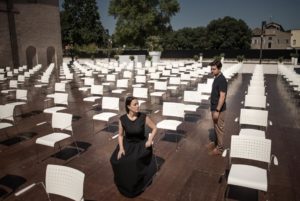 Francesca Leoni and Davide Mastrangelo – Ibrida Festival. Courtesy Leoni & Mastrangelo, photo by Consuelo Canducci
Francesca Leoni and Davide Mastrangelo – Ibrida Festival. Courtesy Leoni & Mastrangelo, photo by Consuelo Canducci
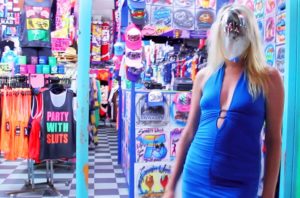 AMERICAN REFLEXXX, SIgne Pierce, 2013 (USA)
AMERICAN REFLEXXX, SIgne Pierce, 2013 (USA)
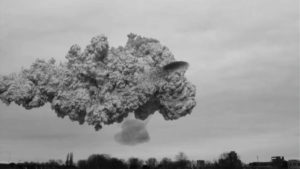 Fran Orallo, Death dance, 2018 (UK)
Fran Orallo, Death dance, 2018 (UK)
 Sofia Braga, I stalk myself more than I should, 2019 (ITA)
Sofia Braga, I stalk myself more than I should, 2019 (ITA)
 Mara Oscar Cassiani, Justice, 2019 (ITA)
Mara Oscar Cassiani, Justice, 2019 (ITA)
 Devis Venturelli, Monumento, 2010 (ITA)
Devis Venturelli, Monumento, 2010 (ITA)
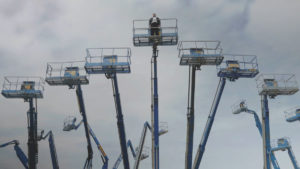 Shir Handelsman, Recitative, 2019 (IL)
Shir Handelsman, Recitative, 2019 (IL)
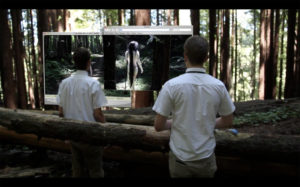 Marina Fini, Tree Temple, 2014 (USA)
Marina Fini, Tree Temple, 2014 (USA)
Graduated in art history at DAMS in Bologna, city where she continued to live and work, she specialized in Siena with Enrico Crispolti. Curious and attentive to the becoming of the contemporary, she believes in the power of art to make life more interesting and she loves to explore its latest trends through dialogue with artists, curators and gallery owners. She considers writing a form of reasoning and analysis that reconstructs the connection between the artist’s creative path and the surrounding context.






NO COMMENT